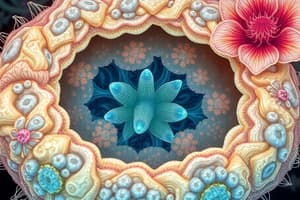Podcast
Questions and Answers
Which organelle is responsible for generating ATP in the cell?
Which organelle is responsible for generating ATP in the cell?
- Mitochondria (correct)
- Ribosomes
- Chloroplasts
- Vacuoles
What is the main function of ribosomes in a cell?
What is the main function of ribosomes in a cell?
- Translating genetic information into proteins (correct)
- Performing photosynthesis
- Generating energy
- Storing nutrients
Which feature is unique to plant cells compared to animal cells?
Which feature is unique to plant cells compared to animal cells?
- Multiple mitochondria
- Cell membrane
- Chloroplasts (correct)
- Presence of ribosomes
Which of the following statements about vacuoles is correct?
Which of the following statements about vacuoles is correct?
What role do mitochondria play in the cell cycle?
What role do mitochondria play in the cell cycle?
In which part of the cell does cellular respiration primarily occur?
In which part of the cell does cellular respiration primarily occur?
What do both plant and animal cells have in common?
What do both plant and animal cells have in common?
Which structure is responsible for controlling the transport of substances into and out of the cell?
Which structure is responsible for controlling the transport of substances into and out of the cell?
Flashcards
Mitochondria
Mitochondria
Organelles that are responsible for generating most of the cell's energy in the form of ATP.
Ribosomes
Ribosomes
Organelles that are responsible for assembling amino acids into proteins.
Cytoplasm
Cytoplasm
The jelly-like substance that fills the cell and contains various organelles.
Vacuole
Vacuole
Signup and view all the flashcards
Photosynthesis
Photosynthesis
Signup and view all the flashcards
Cellular Respiration
Cellular Respiration
Signup and view all the flashcards
Cell Wall
Cell Wall
Signup and view all the flashcards
Nucleus
Nucleus
Signup and view all the flashcards
Study Notes
Plant and Animal Cells - Similarities and Differences
- Both plant and animal cells are eukaryotic cells, containing membrane-bound organelles.
- Both types contain a cell membrane that regulates the transport of substances in and out of the cell.
- Both cell types include cytoplasm, which contains various organelles, including mitochondria.
- Plant cells usually have chloroplasts for photosynthesis.
- Animal cells typically have more mitochondria to produce energy through respiration.
- Plant cells have a cell wall for structural support.
- Plant cells contain a large central vacuole.
- Animal cells do not have a cell wall or large central vacuole.
Cell Organelles
- Cell membrane: Controls the transport of substances into and out of the cell.
- Cytoplasm: A jelly-like substance that fills the cell and contains the organelles.
- Mitochondria: The powerhouse of the cell, where respiration occurs, producing energy in the form of ATP.
- Chloroplasts: Found in plant cells, responsible for photosynthesis to produce glucose.
- Vacuoles: Membrane-bound sacs to store water, nutrients, or waste materials.
- Nucleus: Contains the cell's DNA, controlling cell activities.
Plant Cell Specifics
- Chloroplasts are organelles involved in photosynthesis for energy production.
- Cell wall provides structure and support for the cell.
- A large central vacuole is present to maintain cell turgor pressure.
Animal Cell Specifics
- Animal cells tend to have more mitochondria due to relying on respiration for energy.
- Often lacks a cell wall and a central vacuole.
Mitochondria Function
- Found in most eukaryotic cells.
- Generate most of the cell's energy in the form of ATP.
- Contain their own DNA and ribosomes.
Ribosomes
- Involved in protein synthesis.
- Found in the cytoplasm and on the rough endoplasmic reticulum.
- Composed of ribosomal RNA and proteins.
Studying That Suits You
Use AI to generate personalized quizzes and flashcards to suit your learning preferences.



